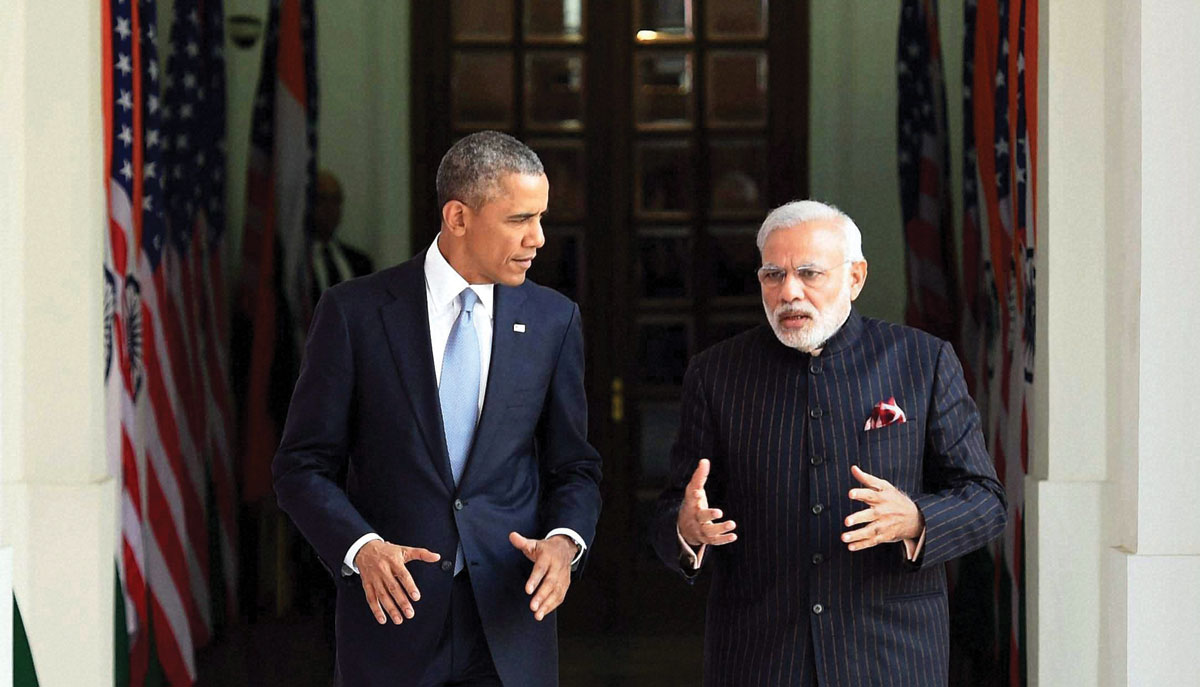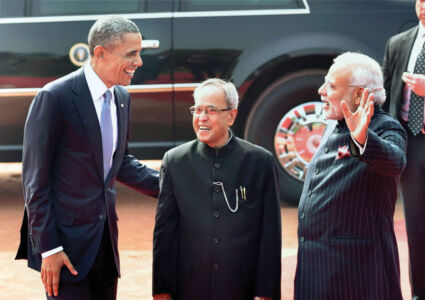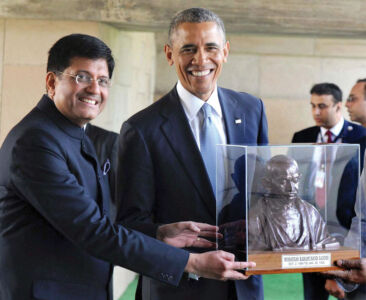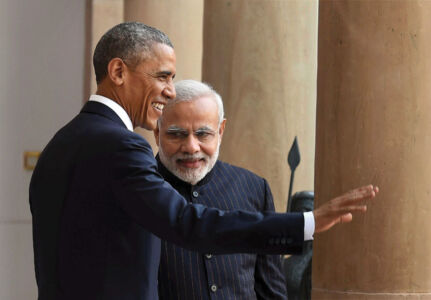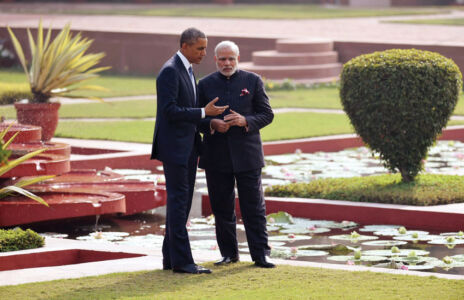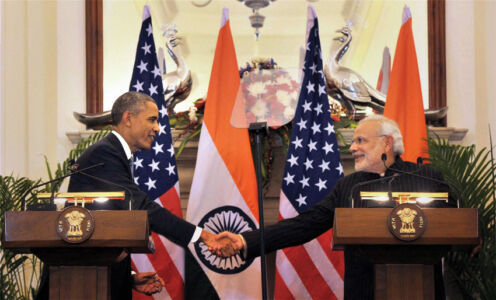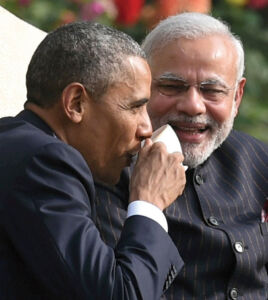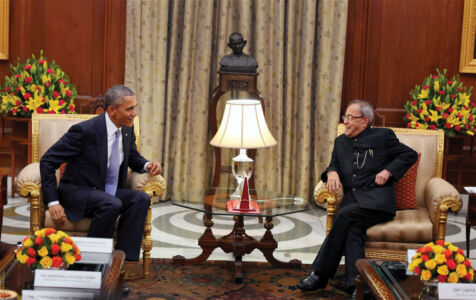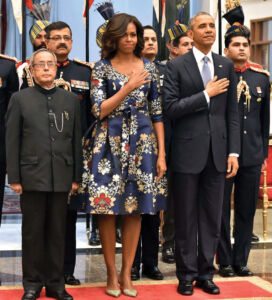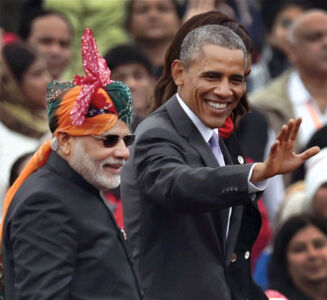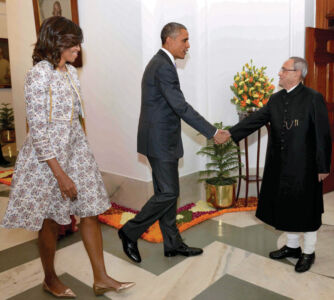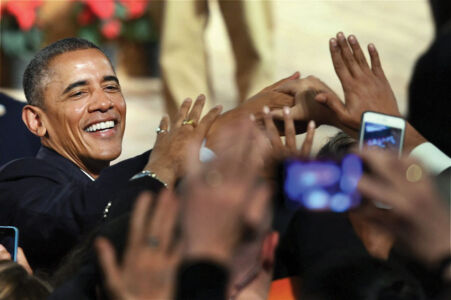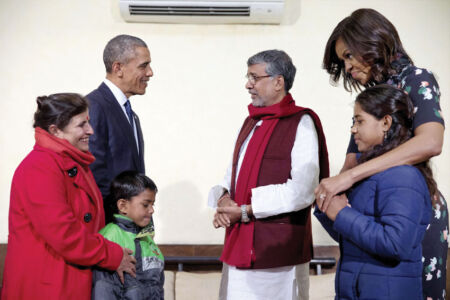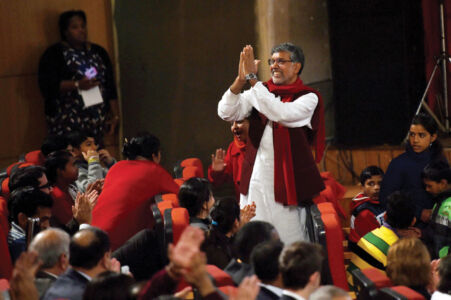NAMASTE INDIA
President Barack Obama and Prime Minister Narendra Modi prior to a meeting at Hyderabad House in New Delhi, Jan. 25. (Atul Yadav | PTI)
For the first time ever, a U.S. President and First Lady were chief guests at a Republic Day Parade in India. President Barack Obama and First Lady Michelle Obama graced India’s 66th Republic Day Parade in New Delhi last month. This was President Obama’s second visit, accompanied by a troupe of high ranking administrators, lawmakers and businessmen, as both President Obama and Prime Minister Narendra Modi collaborated to expand bilateral ties in ways never before imagined. In true Indian tradition of “Atithi Devo Bhava” (treat guests as God), President Obama and First Lady Michelle received the warmest of Indian graciousness and hospitality during their three-day visit, writes Priyanka Bhardwaj.
All roads led to the ITC Maurya Hotel as U.S. President Barack Obama and First Lady Michelle Obama, arrived at a fortified New Delhi in his Air Force One, Jan. 25.
Obama was on a three-day visit to preside over as Chief Guest at the 66th Indian Republic Day parade, held on Jan. 26.
His second visit, accompanied by a troupe of high ranking administrators, lawmakers and businessmen, to the world’s biggest democracy is expected to expand bilateral ties in ways never seen before.
On arrival the U.S. President received a befitting red carpet welcome, complete with a guard of honor and a 21 gun salute, post which he immediately took to a visit to the Rashtrapati Bhavan, Rajghat and Hyderabad House where he also went for a walk through the garden and a casual “chai pe charcha” (conversations over tea) with Prime Minister Modi.
Amidst much aplomb the first day concluded with sealing of a slew of deals touching areas of defense, civil nuclear energy and clean energy.
A five-year nuclear stalemate was broken as both sides strived to breathe fresh life into the partnership and made way for American companies to invest in India’s civilian nuclear development.
After holding extensive talks with Prime Minister Modi, President Obama said, “Today we achieved a breakthrough understanding on two issues that were holding up our ability to advance our civil nuclear cooperation, and we’re committed to moving towards full implementation. And this is an important step that shows how we can work together to elevate our relationship.”
Though specifics of the civil-nuclear deal are still vague, it is clear that the two democracies desire to remove nettles plaguing the conclusion of the deal.
Both India and the U.S. also explored cooperation in other areas of defense and advanced defense technologies.
The renewal of ten-year Defense Trade and Technology Initiative involving joint development and production projects and more in-depth intelligence sharing, maritime security efforts among others was achieved.
The U.S. is actively pursuing “transformative defense technologies” that could be linked to Modi administration’s “Make in India” enterprise.
To attain this Frank Kendall, Under Secretary of Defense for Acquisition, Technology and Logistics (AT&L), and the Pentagon’s point person on India-related defense issues, arrived a few days in advance of the U.S. President, to remove impediments in path of “concrete deliverables” before the Obama-Modi meet.
At the joint media interaction with President Obama, Prime Minister Modi stated, “Today, we have also decided to take our growing defense cooperation to a new level. We have agreed, in principle, to pursue co-development and co-production of specific advanced defense projects.”
Adding to this President Obama said both nations while sharing similar ideas on security and prosperity have also agreed to a “new vision for Asia Pacific” and fight terrorism together by sharing significant intelligence regularly and on a consistent basis, and an intelligence that would be actionable.
This is expected to allay Indian suspicions that U.S.’ selective intelligence sharing in the past had led to acrimonies in the South Asian neighborhood.
With real time intelligence sharing by the U.S., India may gain an edge in tackling cyber terrorism and the problem of fake Indian currency printing by Pakistan.
Regarding renewable energy, a favorite with Modi, a slew of initiatives for reduction of greenhouse emissions and development of India specific renewable technology, especially solar energy, were committed by the U.S.
Without putting a target, but in a break from the past, Prime Minister Modi assured President Obama that, “climate change was an article of faith” for him and that he was determined to battle it.
Three MoUs were signed with the U.S. for developing smart cities in Ajmer, Allahabad and Visakhapatnam, in the Rajasthan, Uttar Pradesh and Andhra Pradesh, respectively.
The Modi government has planned to develop 100 smart cities in the country.
The second day began by Obama’s attendance of the Republic Day parade, a show of military prowess and cultural pageantry, and ended with the signing of a tableaux of deals pertaining to $4 billion worth of new initiatives aimed at increasing trade, investment in renewable energy and infrastructure and improving employment opportunities, and opening up new sources of financing through Indian Diaspora Investment Initiative.
Obama reiterated, “India’s growth in recent decades has lifted countless millions out of poverty and created the world’s largest middle class. There’s an important lesson in that. Growth can’t just be measured by GDP, can’t just be measured by a bottom line on a balance sheet. In the end, growth has to make people’s lives better in real ways.”
And in response Modi stated that in past four months U.S. investments in India had doubled and promised to reduce red tape and make the country a preferred and easy destination for business.
On the third and last day, Obama cut short his India visit in order to fly to Saudi Arabia to pay his respects to the Saudi King after deliberating in South Delhi’s Siri Fort Auditorium on a whole range of subjects, particularly the importance of religious tolerance for India, and later tweeting a “Thank you” to Modi and Indians for the memorable visit and the warm welcome.
His name would go down in history as the first U.S. President to have graced India’s Republic Day Celebrations and visiting India twice while he held office.
What is noteworthy about this entire visit and line of events is that Modi showed his resolve to deal with issues head on and the Americans also reciprocated by imposing trust and confidence in upping their relationship of friendship and cooperation with India.
Traditionally India had viewed the U.S. with suspicion and harbored concerns that U.S. interventions and intentions tended to dent its sovereignty.
However, with President Obama’s second visit bringing many deals to fruition it is likely that we may see the two nations reviewing their relations, cementing their ties, and eventually strengthening the groundwork for their next level of bilateral partnership.
